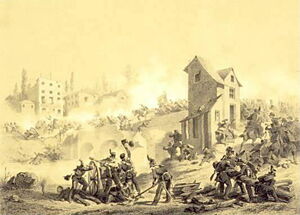
The Battle of Tampico Road, July 1846.
The Rocky Mountain War was a war fought between the Confederation of North America and the United States of Mexico from 1845 to 1855.
Causes of the War
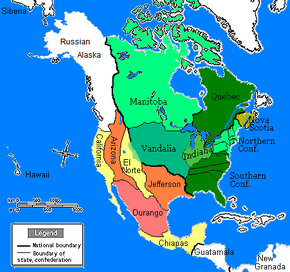
North America on the eve of war, 1845.
The C.N.A.'s first Governor-General, Winfield Scott, sought peaceful relations with the U.S.M., a policy he shared with Mexican President Miguel Huddleston, although neither man discussed it publicly. Huddleston sent his Secretary of State, Isaac Shelby, to Burgoyne to represent the U.S.M. at Scott's investiture. Scott had little taste for war, which he called "the worst form of human activity." However, his peaceful intentions were not shared by his Minister of War, Henry Gilpin, who was more influential among the Unified Liberal Party caucus in the Grand Council. Gilpin called for a contest with the "anarchists and half-breeds" of the U.S.M., and after Assenblyman Pedro Hermión's Scorpions in a Bottle speech in May 1843, be began to pressure Scott to consider a surprise attack against the Mexican cities of Tampico and Jefferson City.
Despite the efforts of Scott and Huddleston, relations between the C.N.A. and U.S.M. continued to worsen, due to the discovery of copper in Mexico del Norte in 1843, and silver early in 1844 in the disputed border area between the state of Mexico del Norte and the confederation of Vandalia. Thousands of Mexican miners arrived from California and Jefferson, and 20,000 North Americans left the eastern Confederations and Indiana for the western border of Vandalia. Attempts to reach a settlement of the border failed, since both countries were able to produce evidence supportiing their claims, and each rejected the other's maps. The disputed Broken Arrow region was more than five million acres, or 7,800 square miles, in extent, and contained some of the wealthiest silver deposits in America.
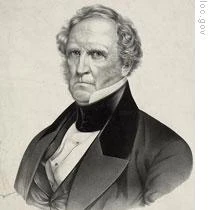
Winfield Scott of Indiana.
The Fighting Begins
By 1845 open war had erupted in the Broken Arrow region between Mexican and North American miners, and armed bands from both sides destroyed the settlements of Kinsey and Morelos. Between February and June, 197 North Americans and 156 Mexicans were killed, and Gilpin increased the pressure for war. In April, Scott and Huddleston agreed to arbitration of the disputed border by a three-nation panel consisting of representatives from the Germanic Confederation, Spain, and the Netherlands. The arbitration panel failed when King Miguel of Spain learned that his representative on the panel would be expected to state specifically where the border between Spain and the C.N.A. had been drawn in the 1799 Treaty of Aix-la-Chapelle. King Miguel feared that doing so would risk bad relations with either the U.S.M. or the C.N.A., or even with both, so he withdrew Spain from the panel. Scott and Huddleston could not agree on a replacement for Spain, and the arbitration plan fell through, as did alternate plans, including a division of the disputed territory.
Scott sought support for his peace program from the National Conservative caucus in the Grand Council, but National Conservative leader Willie Lloyd refused to cooperate. "If Scott cannot control his own party," said Lloyd, "he should resign and allow Gilpin to take command. Better still, let him call a new election, so that the people may judge his party on the record." Scott chose to do neither.
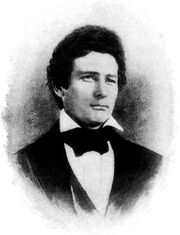
Pedro Hermión of Jefferson.
In the 1845 Mexican elections held on 13 August, the Continentalist Party won fourteen seats in the Mexican Senate, ensuring that Hermión would take office as President of Mexico on 6 September. Scott called a secret meeting of his Cabinet on 28 August to gain support for further negotiations, but Gilpin was able to persuade a majority of the Cabinet ministers to support a declaration of war. Faced with a choice of resigning or accepting the Cabinet's recommendation, Scott chose to remain in office. On the following day, Gilpin sent word to his field commanders to make final preparations for a Mexican attack, and to put the army on a war footing.
In his inaugural address on 6 September, President Hermión said, "We do not want war with any nation, but we do not shrink from action when it is necessary. We know what is ours, and we mean to keep it." Privately, Hermión sent a message to Scott indicating that he would continue the search for peace "in the spirit of my predecessor." Scott called another special Cabinet meeting on 11 September to consider Hermión's message, and to ask for a reconsideration of the declaration of war. Before he could ask for a vote, the meeting was interrupted by Gilpin's aide, Captain Nathan Rusher, who reported that Mexican and North American troops had clashed on 4 September. Scott adjourned the Cabinet meeting without taking any action, and negotiations continued between the two governments, even as military activity in the Broken Arrow region grew in intensity and regularity. By the end of 1845, the two countries were fully engaged, though Sobel suggests that neither side issued a formal declaration of war. Minister of State Bruce Harrison, who opposed the war, resigned from Scott's Cabinet.
First Stage of the War
The C.N.A. was the stronger of the two nations, with a population of 24 million against the U.S.M.'s 16 million (including 200,000 Negro slaves). The North American Navy was the second largest in the world, behind the Royal Navy, while the Mexican Navy was small, and was destroyed during the first two years of the war. The North American Army had half a million men, and would raise another million over the course of the war, while the Mexican Army had only 200,000, and was never greater than 650,000.
On the other hand, the war was fought largely in Mexican territory, giving the Mexicans better knowledge of the terrain and shorter lines of supply. Mexico also had better military leaders, who were given a free hand by Hermión, while Scott, himself a former military commander, continually second-guessed his own generals. Hermión was able to rely on Mexico's Hispanos and Indians to remain loyal and defend their homeland. By contrast, many North American Indians deserted the C.N.A. and served in the Mexican Army, while the Patriotes in Quebec took advantage of the war to demand independence.

The Mexico del Norte campaign, 1846-48.
By the end of 1845, the Mexicans had withdrawn from the disputed area, which was occupied by General Philip Lodge's Northern Confederation militia. In March 1846 Lodge and General Harry Chapin of Indiana crossed into Mexico del Norte, and Colonel Martin Washington of the Southern Confederation crossed the Mississippi River into Jefferson, while General Herbert Williamhouse made an amphibious landing at the Mexican port of Tampico in July and advanced on Mexico City. Washington's men were driven back over the Mississippi after two weeks of fighting. In August the other two North American armies were turned back, with Lodge losing 10,000 men to an army of Cheyenne, while Williamhouse was driven back to Tampico by Major Michael Doheny. Two more North American invasions of Mexico del Norte in 1847 and 1848 were also driven off, and Williamhouse was forced to pull out of Tampico in March 1848.
An attempt by Gilpin to institute a draft in 1848 was met by strikes and anti-draft riots in the N.C., and Gilpin was forced to commit significant numbers of the C.N.A.'s armed forces to maintain control there and in Quebec.In spite of these losses, Scott was renominated by the Unified Liberals in 1848, and was selected for a second term after the 1848 Grand Council elections.
Peace negotiations between the two countries continued, and several months after the election C.N.A. negotiator James Buchanan suggested an armistice based on the status quo ante bellem, with an election to be held in the disputed zone to determine which nation would control it. Mexican envoy Carlos Franklin agreed, and by November peace seemed to be at hand. However, Buchanan and Franklin could not agree on the details of the election or the status of the disputed area beforehand, and negotations broke down in January 1849.
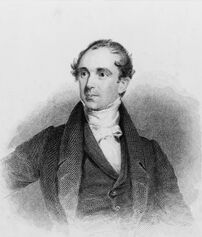
Henry Gilpin of Pennsylvania.
Second Stage of the War
Gilpin was unhappy with Scott's prosecution of the war, and after the Buchanan-Franklin talks broke down, he resigned from the Cabinet and called for a vote of no confidence, claiming that Scott was incompetent and lacked dedication to the fighting men. Between them, Gilpin and Lloyd were able to gain a majority of votes against Scott. However, instead of calling an election, Scott spent three weeks trying to form a coalition government with the National Conservatives, but was unsuccessful. When Gilpin's supporters in the National Liberal caucus voted to expel Scott from the party, he resigned.
Lloyd called for new elections, but Gilpin was able to form a new government by forming a coalition with pro-war National Conservatives. Gilpin was able to survive a vote of no confidence called by Lloyd by a margin of 78 to 72 votes. Afterwards, Gilpin promised to bring the war to a close through "a massive assault on the Mexicans, who shall not rest from our blows."
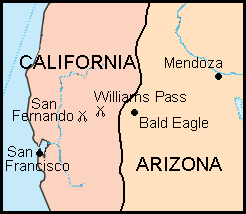
The California Campaign.
Gilpin sent an army under General David Homer west across the Rocky Mountains in an attempt to take San Francisco. After wintering in Mendoza, Arizona, Homer crossed the Sierra Nevadas in 1850, but in July was defeated in the Battle of San Fernando by General Francisco Hernandez's Californians and forced to turn back. A second Mexican army led by Doheny came upon Homer from the east, while a second North American army under General FitzJohn Smithers of the S.C. was hastily dispatched by Gilpin. The four armies remained locked in the Battle of Williams Pass in the Sierra Nevadas through the winter of 1850-51, while suffering fearsome losses. The North Americans ultimately lost 113,000 out of 140,000 men, while the Mexicans lost 66,000 out of 97,000.
Despite the losses suffered by the North Americans, Gilpin rejected the notion that the C.N.A. had suffered a terrible defeat, noting that "Our nation can afford to lose men; the Mexicans cannot. We shall grind them to dust." In the U.S.M., popular opinion turned against the war, and against Hermión. All of his efforts to reassure the nation failed, and there were several assassination attempts made against him, so that he was unable to leave the Presidential Palace without a large contingent of armed guards. By June, fighting was breaking out between supporters and opponents of Hermión.
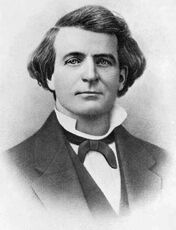
Hector Niles of California.
On 19 June Hermión appeared before Congress to deliver a special message, in which he defended his war policies and denounced his enemies as "turncoats, fair weather friends who run at the first sign of problems." He promised to continue the war "until we drive the last North American from our soil, and then we will march upon Burgoyne, and I will personally dictate peace terms to Gilpin and his jackals." Hermión concluded his address with the words, "We shall never give up! Our Cause is just!" and half the Congress rose and gave him a standing ovation. However, Hermión was immediately assassinated by a former member of the Presidential Guard named Emiliano Zangora, who was killed by the Congressional Guard before he could escape.
The Senate chose Arizona Senator Raphael Blaine, who had served as Hermión's Secretary of State, to serve as Acting President until the national elections in August. Blaine was nominated for his own term by the Continentalists, but was defeated by Assemblyman Hector Niles of California. Niles continued Hermión's defensive strategy, which Gilpin interpreted as an admission of weakness.
Third Stage of the War
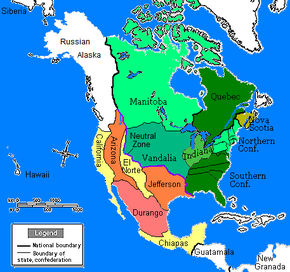
1853 armistice line.
Gilpin launched a new series of offensives in 1852, including a new invasion of Durango and an attack on San Francisco by a fleet under Commodore Daniel Hanson that sailed around Tierra del Fuego. However, Gilpin's offensives were hampered by mutinies in the field, trouble at home, and a growing rejection of the war throughout the C.N.A. A second attempt to take Williams Pass by General Herkemer Ware was defeated by Colonel Miguel Fernandez and Chief Brave Eagle.
By the time of the 1853 Grand Council elections, Gilpin's unpopularity was so great that he declined to run for another term. The Unified Liberals, now simply called the Liberals, nominated former Minister of State Harrison for Governor-General, while the opposition National Conservatives, now simply the Conservatives, nominated Councilman William Johnson of Manitoba. The Conservatives won 91 Grand Council seats to the Liberals' 59, and Johnson took power as Governor-General on 16 February.
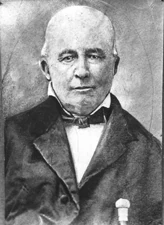
William Johnson of Manitoba.
Johnson and Niles agreed to a battlefield truce in August while teams of negotiators from both nations met in The Hague. The arbitration panel from 1845 was revived, since the death of King Miguel in 1851 removed the obstacle to Spain's participation. The panel began meeting in November, and issued a final report on June 15, 1854. The report recommended that the U.S.M. cede a small portion of Mexico del Norte to the C.N.A., and that the C.N.A. pay the U.S.M. NA£2,500,000 in indemnities. The two nations accepted the panel's findings, and a formal peace treaty was signed on 7 August 1855 by Senator Frank Rinehart of the U.S.M. and Minister of War John Wolff of the C.N.A.
Sources
Sobel's sources for the Rocky Mountain War are the official accounts of the C.N.A. (Burgoyne, 1888-1899) and U.S.M. (Mexico City, 1910-1925), the Burgoyne Times for 20 May 1849 and 3 December 1852, Gilpin's No Apologies are in Order: My Term as Governor (New York, 1860), Buchanan's The Paris Mission and Other Episodes (New York, 1868), General Sir Hugh Brandon's The Lodge Campaign of 1845-48 (London, 1882), Lord Henry Hawkes' Logistics and Tactics in the Border War (London, 1888), William Cocke's Caesar in Broadcloth (New York, 1910), General Wesley McDouglall's The Relative Strengths of the C.N.A. and the U.S.M. in the Rocky Mountain War (London, 1911) and The Lessons of the Rocky Mountain War (London, 1914), Martin York's Huddleston, Scott, and the Rapprochement of 1844 (Mexico City, 1929), David Marks's Hector Niles: The Mexican Augustus (Mexico City, 1949), James Boatwright's Pedro Hermión: A Hero in His Own Land (Mexico City, 1954), Harper Reichart's The Elections of 1845: The Mandate for War (Mexico City, 1956), Frank McKinley's Winfield Scott and the Sin of Pride (Mexico City, 1957), John Pritchard's The First Shot: Origins of the Rocky Mountain War (Mexico City, 1958) and He Was First! The Governorship General of Winfield Scott (New York, 1960), Carlos McBride's The U.S.M. Elections of 1851: The End of an Era (Mexico City, 1960), Ernest Passman's Lloyd of Carolina: A Political Biography (New York, 1965), Ellsworth Crown's collection A Bibliography of the Rocky Mountain War (New York, 1966), Samuel Collum's The Home Front: A History of the C.N.A. in the Rocky Mountain War (New York, 1967), Frank Taft's The End of the War: The Hague in 1853-1855 (Melbourne, 1967), Winsor Watkins' The Late Bloomer: William Johnson and the Election of 1853 (New York, 1969), Edgar Almond's Michael Doheny: The War Years (Mexico City, 1969), George Loring's collection Origins of the Rocky Mountain War (London, 1969), John Conroy's The Rhetoric of Pedro Hermión: A Study in Mob Psychology (London, 1970), and Adlai Groggins' "New Revelations from the Scott Papers" Burgoyne Herald and Times, January 14-18, 1971.
This was the Featured Article for the week of 13 January 2013.
| C.N.A. Historical Eras |
|---|
| American Crisis • North American Rebellion • Four Viceroys • Britannic Design • Dickinson Era • Trans-Oceanic War • Era of Harmonious Relations • Crisis Years • Rocky Mountain War • Era of Faceless Men • Age of Renewal • Bloody Eighties • Creative Nationalism • Starkist Terror • Years of the Pygmies • Malaise Years • Diffusion Era • Global War • New Day • War Without War |
